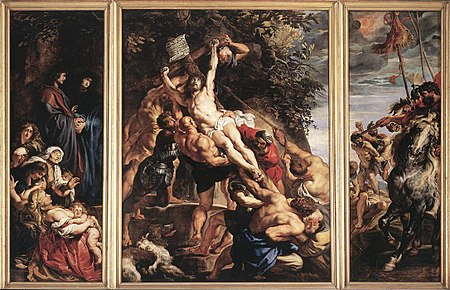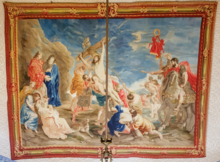| The Elevation of the Cross | |
|---|---|
 | |
| Artist | Peter Paul Rubens |
| Year | 1610–11 |
| Medium | Oil on wood |
| Dimensions | 462 cm × 341 cm (182 in × 134 in) |
| Location | Cathedral of Our Lady, Antwerp |
The Elevation of the Cross (also called The Raising of the Cross) is the name of two paintings, a very large triptych in oil on panel and a much smaller oil on paper painting.[1] Both pieces were painted by the Flemish artist Peter Paul Rubens in Antwerp, Belgium, the original in 1610 and the latter in 1638.[1] The original is a winged altarpiece, with the outside of the hinged wings also painted. These can be folded over the central panel, giving an 'open view' and a 'closed view'.
The original is in the Cathedral of Our Lady, as the Catholic church for which it was painted has been destroyed. The smaller version is now in the Art Gallery of Ontario, Canada. Another smaller triptych with a different composition, and an oil study, are in the Louvre in Paris.

In the Episcopal Palace of Segovia, an 18th-century tapestry replicating this triptych is preserved. Crafted by Jean-Baptiste Vermillion, it is notable for its size and the vividness of its colors.
Peter Paul Rubens painted the triptych The Elevation of the Cross after returning to Antwerp from Italy in 1610–1611 as commissioned by the church authorities of the Church of St. Walburga.[1] Cornelis van der Geest, a wealthy merchant and churchwarden of the Catholic Church of St. Walburga, secured this commission for Rubens and funded the majority of the project.[1]

The Antwerp triptych was positioned above the high altar preceded by a set of stairs, making it visible from a great distance in the vast Gothic cathedral of St. Walburga.[2] This height was unusual for an altarpiece indicating its important presence in St. Walburga.[2] While Rubens' triptych was present in St. Walburga, the painting was surrounded on all sides by images of God the Father, Christ, angels, and at the top of the structure was a gilded wooden pelican, which was a common representation of Christ's redemptive sacrifice, based on the ancient legend that the pelican hacked his brood to death in a first rage, but then brought them back to life with his own blood.[3]
- ^ a b c d Martin, John (1969). Rubens: The Antwerp Altarpieces. New York, NY: Thames & Hudson Ltd. pp. 37–39. ISBN 0500460035.
- ^ a b Belkin, Kristin (1998). Rubens. London, England: Phaidon Press. pp. 103–120. ISBN 9780714834122.
- ^ Heinen, Ulrich (1996). Der Hochaltar für die Walburgenkirche in Antwerpen, Weimar: Verlag und Datenbank fuer Geisteswissenschaften. Weimar: Verlag und Datenbank für Geisteswissenschaften. pp. 49–79. ISBN 3929742861.